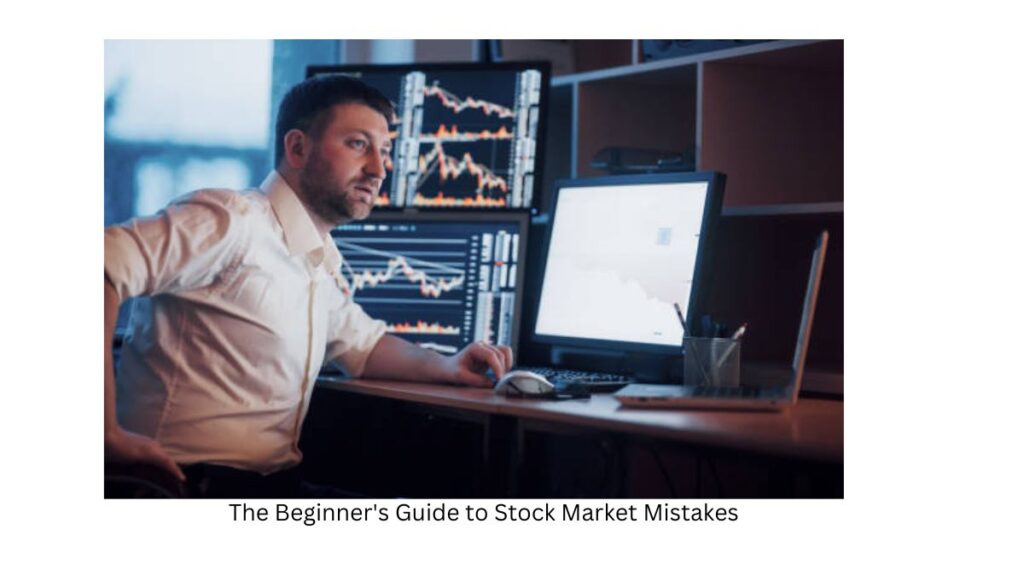Introduction:-
The Beginner’s Guide to Stock Market Mistakes: What to Watch Out For

Are you a novice investor eager to dip your toes into the exciting world of stock markets? While investing in stocks can be a promising way to grow your wealth, it’s essential to tread cautiously, as common mistakes can potentially impact your financial journey. In this beginner’s guide, we’ll explore the most typical stock market mistakes and provide insights on how to avoid them.
What are some of the most common stock market mistakes, and can you offer advice on how to prevent or mitigate them?
Mistake 1: Lack of Research
One of the most common pitfalls for beginners is diving into stock market investments without adequate research. Successful investing requires a fundamental understanding of the companies or assets you’re investing in. To avoid this mistake, start by:

- Educating Yourself: Take the time to learn the basics of stock market investing. Numerous online resources, books, and courses are available to help you get started.
- Research Companies: Before buying a stock, research the company’s financial health, competitive position, and growth prospects. Make informed decisions based on your findings.
Mistake 2: Overlooking Diversification
Another mistake is putting all your money into a single stock or asset. Concentrating your investments in one area can increase risk significantly. To overcome this, consider diversifying:
- Diversify Your Portfolio: Spread your investments across different sectors and asset classes. Diversification can help reduce risk and protect your portfolio from the impact of a single underperforming asset.
- Consider Mutual Funds or ETFs: If you’re unsure about individual stocks, consider investing in mutual funds or exchange-traded funds (ETFs) that provide instant diversification.
Mistake 3: Emotional Decision-Making
Emotions often drive impulsive investment decisions, which can lead to buying high and selling low. To steer clear of this error:
- Have a Strategy: Develop an investment strategy or plan and stick to it. Whether it’s long-term or short-term, having a plan can help you avoid making rash decisions.
- Avoid Following the Herd: Don’t base your decisions on market hype or popular trends. Research, analysis, and discipline should be your guiding principles.
Mistake 4: Neglecting Risk Management
Failing to consider the risks associated with investments is another significant blunder. To manage risk effectively:
- Set Stop-Loss Orders: Consider using stop-loss orders to limit potential losses. These orders automatically sell a stock when it reaches a predetermined price.
- Assess Your Risk Tolerance: Understand your risk tolerance and only invest what you can afford to lose. A well-thought-out risk management strategy can help protect your capital.
Mistake 5: Not Reviewing and Adapting
Lastly, a common mistake is not regularly reviewing and adapting your investment strategy. Markets change, and so should your approach:
- Regularly Review Your Portfolio: Periodically assess your investments to ensure they align with your goals and risk tolerance.
- Stay Informed: Keep yourself updated on market trends, economic developments, and any news that may impact your investments.
What are 3 high-risk investments?
High-risk investments are those that have the potential for significant financial gain but also come with a substantial risk of loss. Here are three examples of high-risk investments:
- Penny Stocks: Penny stocks are shares of small companies with low market capitalization, typically trading for less than $5 per share. While they may seem like an attractive investment due to their low price, they are highly speculative and volatile. Penny stocks can be manipulated by fraudulent schemes, and their prices can fluctuate dramatically. Investors can quickly lose a substantial portion of their investment in penny stocks.
- Cryptocurrencies: Cryptocurrencies like Bitcoin, Ethereum, and many others have gained popularity in recent years. While they offer the potential for high returns, they are also extremely volatile and speculative. Cryptocurrency markets are largely unregulated and subject to rapid price fluctuations. Investors should be prepared for the risk of losing a significant portion of their investment in a short period.
- Startups and Venture Capital: Investing in startups and early-stage companies through venture capital or private equity can yield substantial returns if the company succeeds. However, the failure rate for startups is high, and many do not survive. Investing in startups requires a high tolerance for risk and a willingness to accept the possibility of losing the entire investment.
What risks should people avoid when they invest in the stock market?
When investing in the stock market, there are several risks that people should be aware of and aim to avoid or mitigate. These risks include:

- Market Risk: Market risk, also known as systematic risk, is the risk associated with overall market movements. It’s challenging to avoid entirely, but diversification can help spread this risk. Diversifying your portfolio across different asset classes and industries can reduce your exposure to market fluctuations.
- Company-Specific Risk: This risk pertains to individual companies or stocks. Company-specific risks include poor financial performance, management issues, or legal problems. To mitigate this risk, conduct thorough research on the companies you invest in and consider diversifying your stock holdings.
- Lack of Research: Failing to research and understand the investments you make can lead to poor decision-making. To avoid this risk, take the time to learn about the companies you’re investing in, their financial health, and their competitive position in the market.
- Emotional Decision-Making: Emotional decisions, such as panic selling during market downturns or chasing hot trends, can lead to poor investment outcomes. Developing a well-defined investment strategy and sticking to it can help avoid impulsive decisions driven by emotions.
- Overconcentration: Concentrating your investments in a single stock or asset class can lead to a higher level of risk. Diversifying your portfolio across various investments can help reduce the impact of one underperforming asset.
- Lack of a Clear Strategy: Investing without a clear strategy or plan can be risky. Establish your financial goals and create a strategy that aligns with them. Regularly review and adjust your strategy as needed.
- Ignoring Risk Tolerance: Investing beyond your risk tolerance can lead to anxiety and poor decision-making. Assess your risk tolerance and invest accordingly. If you’re uncomfortable with high-risk investments, choose a more conservative approach.
- Chasing Performance: Investing in assets solely because they have recently performed well can be a mistake. Past performance is not always indicative of future results. Make investment decisions based on long-term goals and sound analysis, not short-term trends.
- Timing the Market: Trying to predict market highs and lows can lead to missed opportunities and losses. Time in the market is often more important than timing the market. Stay invested and avoid market-timing strategies.
- Not Staying Informed: Failing to stay informed about market trends, economic developments, and changes in the financial landscape can increase your risk. Regularly update your knowledge and adjust your investment strategy accordingly.
In conclusion,
As a beginner in the stock market, you can avoid many common mistakes by staying informed, diversifying your investments, managing risk, and sticking to a well-defined strategy. Remember that investing is a journey, and learning from your mistakes is a valuable part of the process. By being mindful of these potential pitfalls, you can set yourself on a path to becoming a more successful and informed investor.





